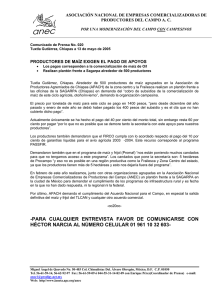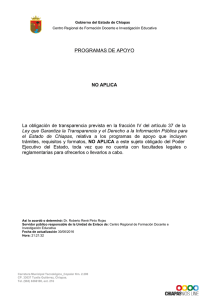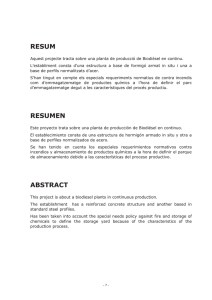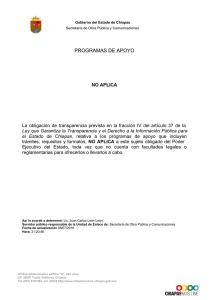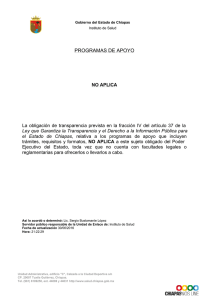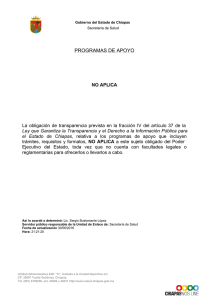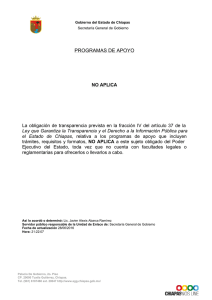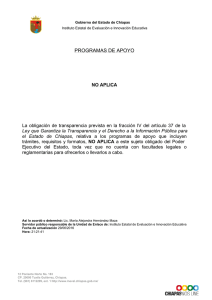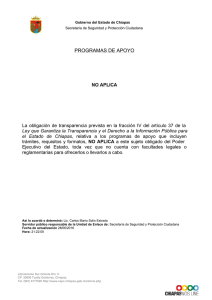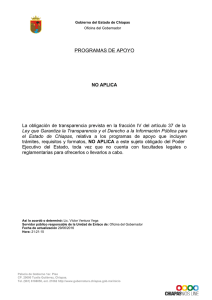CAPACIDAD DE ALMACENES Y DEMANDA DE
Anuncio
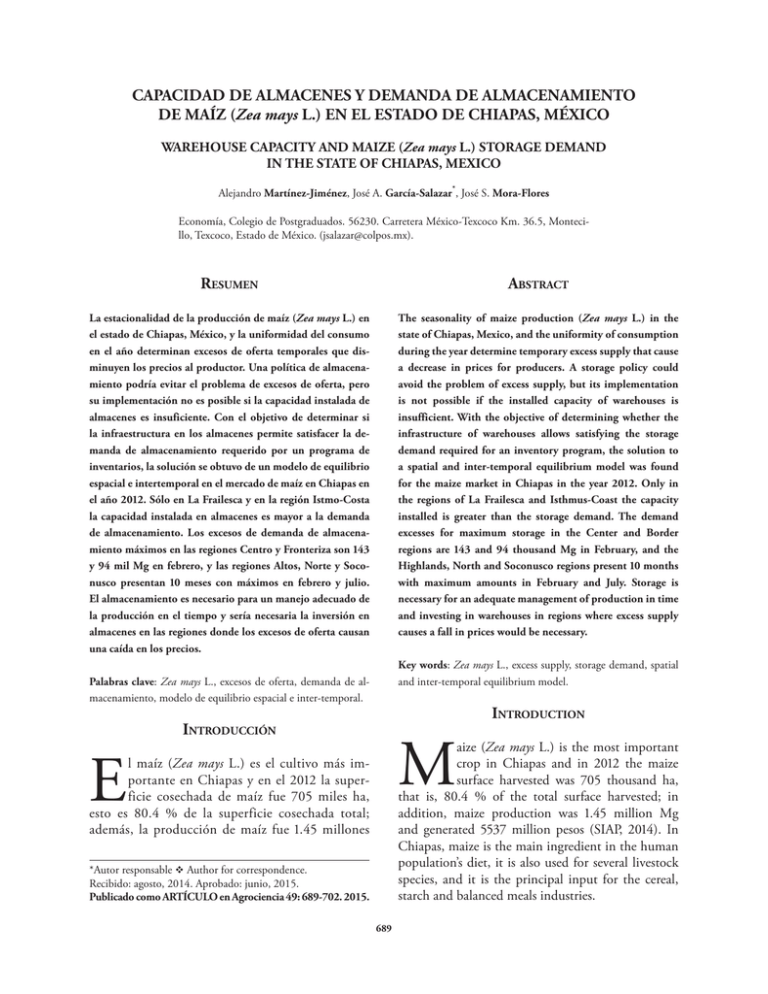
CAPACIDAD DE ALMACENES Y DEMANDA DE ALMACENAMIENTO DE MAÍZ (Zea mays L.) EN EL ESTADO DE CHIAPAS, MÉXICO WAREHOUSE CAPACITY AND MAIZE (Zea mays L.) STORAGE DEMAND IN THE STATE OF CHIAPAS, MEXICO Alejandro Martínez-Jiménez, José A. García-Salazar*, José S. Mora-Flores Economía, Colegio de Postgraduados. 56230. Carretera México-Texcoco Km. 36.5, Montecillo, Texcoco, Estado de México. ([email protected]). Resumen Abstract La estacionalidad de la producción de maíz (Zea mays L.) en el estado de Chiapas, México, y la uniformidad del consumo en el año determinan excesos de oferta temporales que disminuyen los precios al productor. Una política de almacenamiento podría evitar el problema de excesos de oferta, pero su implementación no es posible si la capacidad instalada de almacenes es insuficiente. Con el objetivo de determinar si la infraestructura en los almacenes permite satisfacer la demanda de almacenamiento requerido por un programa de inventarios, la solución se obtuvo de un modelo de equilibrio espacial e intertemporal en el mercado de maíz en Chiapas en el año 2012. Sólo en La Frailesca y en la región Istmo-Costa la capacidad instalada en almacenes es mayor a la demanda de almacenamiento. Los excesos de demanda de almacenamiento máximos en las regiones Centro y Fronteriza son 143 y 94 mil Mg en febrero, y las regiones Altos, Norte y Soconusco presentan 10 meses con máximos en febrero y julio. El almacenamiento es necesario para un manejo adecuado de la producción en el tiempo y sería necesaria la inversión en almacenes en las regiones donde los excesos de oferta causan una caída en los precios. The seasonality of maize production (Zea mays L.) in the state of Chiapas, Mexico, and the uniformity of consumption during the year determine temporary excess supply that cause a decrease in prices for producers. A storage policy could avoid the problem of excess supply, but its implementation is not possible if the installed capacity of warehouses is insufficient. With the objective of determining whether the infrastructure of warehouses allows satisfying the storage demand required for an inventory program, the solution to a spatial and inter-temporal equilibrium model was found for the maize market in Chiapas in the year 2012. Only in the regions of La Frailesca and Isthmus-Coast the capacity installed is greater than the storage demand. The demand excesses for maximum storage in the Center and Border regions are 143 and 94 thousand Mg in February, and the Highlands, North and Soconusco regions present 10 months with maximum amounts in February and July. Storage is necessary for an adequate management of production in time and investing in warehouses in regions where excess supply causes a fall in prices would be necessary. Key words: Zea mays L., excess supply, storage demand, spatial and inter-temporal equilibrium model. Palabras clave: Zea mays L., excesos de oferta, demanda de almacenamiento, modelo de equilibrio espacial e inter-temporal. Introduction Introducción M aize (Zea mays L.) is the most important crop in Chiapas and in 2012 the maize surface harvested was 705 thousand ha, that is, 80.4 % of the total surface harvested; in addition, maize production was 1.45 million Mg and generated 5537 million pesos (SIAP, 2014). In Chiapas, maize is the main ingredient in the human population’s diet, it is also used for several livestock species, and it is the principal input for the cereal, starch and balanced meals industries. E l maíz (Zea mays L.) es el cultivo más importante en Chiapas y en el 2012 la superficie cosechada de maíz fue 705 miles ha, esto es 80.4 % de la superficie cosechada total; además, la producción de maíz fue 1.45 millones *Autor responsable v Author for correspondence. Recibido: agosto, 2014. Aprobado: junio, 2015. Publicado como ARTÍCULO en Agrociencia 49: 689-702. 2015. 689 AGROCIENCIA, 16 de agosto - 30 de septiembre, 2015 Mg y generó 5537 millones de pesos (SIAP, 2014). En Chiapas el maíz es el ingrediente principal en la alimentación de la población humana, también en varias especies ganaderas, y es el insumo principal en las industrias de cereales, almidones y alimentos balanceados. El Censo Agropecuario de 2007 reportó 335 mil unidades de producción dedicadas al cultivo de maíz en Chiapas (INEGI, 2007), para las cuales la actividad maicera es una fuente importante de ingresos. Una disminución en el ingreso de la unidad de producción perjudica al productor porque reduce su ingreso y la posibilidad de adquirir insumos. La variación en el ingreso podría provenir de variaciones en el rendimiento o en el precio del cereal. Condiciones climáticas adversas pueden reducir el rendimiento por hectárea y situaciones desfavorables en el mercado disminuirían el precio que recibe el productor; en ambos casos el ingreso es menor. De acuerdo con la Asociación Nacional de Empresas Comercializadoras de Productores del Campo (ANEC, 2013), la problemática actual de los productores de granos del Sureste del país es la disminución anual del precio al productor de los principales granos cultivados en la región: maíz, sorgo (Sorghum vulgare Pers) y frijol (Phaseolus vulgaris L.). El precio de maíz pasó de 5000 $ Mg1 en 2011 a sólo 3000 $ Mg1 en 2013, esto es una reducción de 40 %, mientras que los insumos agrícolas (fertilizantes y semilla) crecieron 60 % (ANEC, 2013). La variación en los precios es función de los cambios en la oferta y la demanda en el tiempo, la estacionalidad de la demanda es consecuencia de costumbres y tradiciones, mientras que los efectos del clima y la naturaleza biológica del cultivo determinan la estacionalidad de la producción de maíz. Debido a que el consumo del cereal es más uniforme en el tiempo que la producción, los excesos de oferta se presentan frecuentemente a través del año, los cuales reducen el precio del maíz. Por ejemplo, en los meses de producción mayor, como enero, febrero, marzo, abril y mayo de 2011, el precio al mayoreo del maíz en la central de abasto de Tuxtla Gutiérrez fue menor en 25.5, 25.5, 15.6, 9.0 y 9.0 %, respectivamente, al precio anual promedio (de 6 $ kg1). Por el contrario, en meses de producción menor como septiembre, octubre y noviembre del mismo año el precio mensual de 690 VOLUMEN 49, NÚMERO 6 The 2007 Agricultural Census reported 335 thousand production units devoted to maize cultivation in Chiapas (INEGI, 2007), for which maize activity is an important source of income. A decrease in income from the production unit harms the producer because it reduces his/her income and the possibility to acquire inputs. Variation in income could be the result of variations in the yield or in the cereal’s prize. Adverse climate conditions can reduce the yield per hectare and unfavorable situations in the market would decrease the price that the producer receives; in both cases the income obtained is lower. According to the National Association of Marketing Enterprises of Field Producers (Asociación Nacional de Empresas Comercializadoras de Productores del Campo, ANEC, 2013), the current problem of grain producers in the country’s Southeast is the annual decrease of the price for the producer of main grains cultivated in that region: maize, sorghum (Sorghum vulgare Pers) and bean (Phaseolus vulgaris L.). The price of maize went from 5000 $ Mg1 in 2011 to only 3000 $ Mg1 in 2013, which is a reduction of 40 %, while the agricultural inputs (fertilizers and seeds) increased 60 % (ANEC, 2013). The variation in prices is a function of the changes in supply and demand in time, the seasonality of the demand is consequence of customs and traditions, whereas the effects of the climate and biological nature of the crop determine the seasonality of maize production. Because the consumption of cereal is more uniform in time than the production, excess supply occur frequently throughout the year, causing a fall in the maize price. For example, in the months of highest production such as January, February, March, April and May, 2011, the wholesale maize price in the wholesale market in Tuxtla Gutiérrez was lower in 25.5, 25.5, 15.6, 9.0 and 9.0 %, respectively, than the average annual price (of 6 $ kg1). On the contrary, in months of lower production such as September, October and November of the same year, the monthly price of maize was 15 % higher than the average annual price (SNIIM, 2015). The temporary excess supply could be eliminated with a policy for storage and preservation of the cereal. Storage is concentrating the production in selected places and preservation implies providing the stored products with the necessary conditions to avoid CAPACIDAD DE ALMACENES Y DEMANDA DE ALMACENAMIENTO DE MAÍZ (Zea mays L.) EN EL ESTADO DE CHIAPAS, MÉXICO maíz fue mayor en 15 % al precio anual promedio (SNIIM, 2015). Los excesos temporales de oferta se podrían eliminar con una política de almacenamiento y conservación del cereal. El almacenamiento es concentrar la producción en lugares seleccionados y la conservación implica proporcionar a los productos almacenados las condiciones necesarias para evitar daños por plagas, enfermedades o el medio ambiente, así como mermas, reducción en la calidad, o la pérdida total (Ayala-Garay y Carrera-Chávez, 2008). El almacenamiento de granos requiere entender los procesos físicos y biológicos al interior del grano, y buenas prácticas de administración (Hernández y Carballo, 2003). Un almacenamiento y conservación de granos adecuado requiere: 1) Controlar la temperatura y la humedad del grano al interior de la bodega para evitar proliferación de hongos y enfermedades que ocurren con excesos de calor y humedad; 2) mantener el grano lejos de insectos, pájaros y otras plagas que puedan causar daño físico; 3) usar bodegas secas, limpias y libres de plagas, donde se almacenen granos secos, enteros, sanos y sin impurezas. El objetivo es que el producto almacenado se mantenga fresco, seco y protegido de insectos, pájaros, hongos y roedores (Hernández y Carballo, 2003). Las acciones de almacenamiento serían almacenar parte de la producción de los meses de alta oferta para crear un flujo de producto al mercado más uniforme en el tiempo. El almacenamiento podría ocurrir en los meses de bajos precios y aumentar el flujo del producto al mercado durante los meses de escasez con precios más altos (García-Salazar et al., 2011). La concentración de maíz en almacenes tendría varios objetivos como el acopio para su movilización posterior en grandes volúmenes, que permitiría reducir el costo de transporte. Además, con el control y el manejo de los inventarios podría disminuir la participación de los intermediarios, evitando la caída de los precios al productor. La posibilidad de implementar una política de almacenamiento en Chiapas genera entonces las siguientes preguntas ¿Cuál es la magnitud de la demanda de almacenamiento que requiere un manejo óptimo de los inventarios?, ¿cuál es la capacidad instalada de los almacenes agrícolas en la entidad? y ¿es esa capacidad suficiente para cubrir la demanda de almacenamiento? damages from pests, diseases or the environment, as well as shrinkage, reduction in quality, or total loss (Ayala-Garay and Carrera-Chávez, 2008). Grain storage requires understanding the physical and biological processes inside the grain, as well as good management practices (Hernández and Carballo, 2003). An adequate storage and preservation of grains requires: 1) controlling temperature and moisture of the grain inside the warehouse to avoid proliferation of fungi and diseases that occur with excess heat and moisture; 2) maintaining the grain far from insects, birds and other pests that can cause physical harm: 3) using dry, clean and pest-free warehouses, where dry, whole, healthy and spot-free grains are stored. The objective is that the stored product keepsfresh, dry and protected from insects, birds, fungi and rodents (Hernández and Carballo, 2003). The storage actions would be holding part of the production from the high-supply months to create a more uniform product flow towards the market in time. Storage could take place during months of low prices and then increase the product flow to the market during the months of scarcity, when prices are higher (García-Salazar et al., 2011). The maize concentration in warehouses would have several objectives, such as stockpiling for its later mobilization in large volumes, which would allow reducing the transportation cost. In addition, the participation of intermediaries could decrease with the control and management of inventories, thus preventing the fall of prices for the producer. The possibility of implementing a policy for storage in Chiapas generates, then, the following questions: What is the magnitude of the storage demand that requires an optimal management of inventories? Which is the installed capacity of the agricultural warehouses in the state? and, is this capacity sufficient to cover the storage demand? In order to answer the first question, it is necessary to analyze aspects related to the logistics of supply and distribution of consumption and production of the grain in the state. The demand for storage depends on: 1) the magnitude of production; if it is concentrated in a month, the storage demand is greater, but when the supply is more uniform in time, it is consumed and there is no need to store; 2) the existence of transport from the producing zone to the market allows a fast mobilization of the product and reduces the need for storage; 3) a high MARTÍNEZ-JIMÉNEZ et al. 691 AGROCIENCIA, 16 de agosto - 30 de septiembre, 2015 Para responder la primera pregunta es necesario analizar aspectos relacionados con la logística de abasto y distribución del consumo y producción del grano en la entidad. La demanda por almacenamiento depende de: 1) la magnitud de la producción y si se concentra en un mes la demanda de almacenamiento es mayor, pero cuando la oferta es más uniforme en el tiempo, se consume y no hay necesidad de almacenar; 2) la existencia de transporte de la zona productora al mercado permite una movilización rápida del producto y reduce la necesidad de almacenamiento; 3) un consumo alto en la zona productora demanda más producción, disminuye el exceso de oferta temporal y por tanto del almacenamiento (García-Salazar et al., 2000). En Chiapas hay una marcada estacionalidad en la producción de maíz; en diciembre, enero y febrero se obtiene 66.9 % de la producción anual (SIAP, 2012), y la necesidad de almacenamiento es mayor que en los meses de producción mínima. Para responder la segunda pregunta se usaron datos de la capacidad instalada de almacenes bajo techo y a la intemperie en los estados de México en el 2013 (ASERCA, 2013) (Cuadro 1): 1) Una concentración de almacenes en los estados del Noroeste y Noreste, y su capacidad instalada fue 49.9 % en Sinaloa, Sonora y Tamaulipas; 2) los estados de Oaxaca y Guerrero tienen sólo 0.2 % de dichos almacenes. En Chiapas la capacidad para almacenar bajo techo fue 333 mil Mg de granos y semillas oleaginosas, lo cual es 1.2 % de la capacidad nacional en 2013, pero la producción de maíz en enero de ese año fue mayor a 400 mil Mg. Esto indica que en Chiapas la infraestructura de almacenamiento sería insuficiente para almacenar los excesos de oferta generados en la cosecha; además, se cosechan otros productos que se pueden almacenar, lo cual aumenta la demanda por almacenamiento. La existencia de infraestructura de almacenamiento suficiente es importante porque la seguridad alimentaria solo se puede obtener con una red de infraestructura de almacenamiento, y una red de vías de comunicación para el acceso a todas las zonas productoras y consumidoras agrícolas en el país. Los almacenes deben ser suficientes, amplios y adecuados, y permitir la disponibilidad, el acceso, la sanidad y la inocuidad en forma estable y sostenible. 692 VOLUMEN 49, NÚMERO 6 consumption in the producing zone will demand more production, decrease the temporary excess supply and, therefore, the need for storage (GarcíaSalazar et al., 2000). In Chiapas there is a marked seasonality in maize production; in December, January and February, 66.9 % of the annual state’s production is obtained (SIAP, 2012), and this is when the need for storage is higher than in the months of minimum production. To answer the second question, data of installed capacity of roofed and open-air warehouses in Mexican states in 2013 (ASERCA, 2103) (Table 1) were used: 1) A concentration of warehouses in the Northwestern and Northeastern states, and their installed capacity was 49.9 % in Sinaloa, Sonora and Tamaulipas; 2) the states of Oaxaca and Guerrero have only 0.2 % of these warehouses. In Chiapas, the storage capacity under roofs was 333 thousand Mg of grains and oilseeds, which is 1.2 % of the national capacity in 2013, but maize production in January of that year was over 400 thousand Mg. This indicates that in Chiapas the storage infrastructure would be insufficient to store the excess supply generated in the harvest; in addition, in this state other products are harvested that could be stored, increasing the demand for storage. The existence of sufficient storage infrastructure is important because food security can only be achieved by having a storage infrastructure network and a road network for access to all agricultural producing and consuming zones in the country. Warehouses should be sufficient, spacious and adequate, allowing availability, access, healthiness and innocuousness in a stable and sustainable manner. Sufficient infrastructure to store grains in Chiapas will allow better standards of living for producers, who will obtain a better price and stability in the market. In addition, maize production would be encouraged and the adoption of new technological packages would be fostered, in order to increase the productivity and production volume in the state. This study is justified because: 1) Chiapas is the fifth maize producer in the country; 2) due to insufficient infrastructure, not all seasonal excess supply are stored, which reduces prices for the producer; 3) an inventory program in the state would help decrease the participation of intermediaries; 4) there is a high potential to increase production CAPACIDAD DE ALMACENES Y DEMANDA DE ALMACENAMIENTO DE MAÍZ (Zea mays L.) EN EL ESTADO DE CHIAPAS, MÉXICO Cuadro 1. Capacidad instalada de almacenes agrícolas por estado en 2013, México (miles Mg). Table 1. Installed capacity of agricultural warehouses per state in 2013, Mexico (thousands Mg). Estado Aguascalientes Baja California Baja California Sur Campeche Coahuila Colima Chiapas Chihuahua Distrito Federal Durango Guanajuato Guerrero Hidalgo Jalisco Estado de México Michoacán Morelos Nayarit Nuevo León Oaxaca Puebla Querétaro Quintana Roo San Luis Potosí Sinaloa Sonora Tabasco Tamaulipas Tlaxcala Veracruz Yucatán Zacatecas Nacional Naves 1 Silos 2 26 78 14 95 25 15 195 1294 0 457 2107 36 15 2227 50 682 118 160 84 11 330 81 0 43 2810 1594 28 3715 30 174 42 439 16 975 40 92 0 111 14 6 139 489 63 91 584 4 34 1166 81 273 37 28 145 4 161 200 0 12 3455 1214 15 680 218 69 486 88 10 001 Bajo techo Intemperie 312 4 66 171 14 206 39 21 333 1783 63 549 2691 40 48 3393 131 956 155 188 229 15 490 282 0 55 6265 2808 43 4395 247 243 528 527 26 975 0 1088 16 5 6 0 189 242 0 15 597 64 2 418 0 331 117 144 5 10 13 17 0 24 448 1322 0 393 12 5 0 5 5487 Total 534 % 66 1259 31 211 45 21 522 2025 63 563 3288 104 50 3811 131 1287 271 332 234 24 503 299 0 79 6713 4130 43 4788 259 248 528 532 32 462 0.2 3.9 0.1 0.7 0.1 0.1 1.6 6.2 0.2 1.7 10.1 0.3 0.2 11.7 0.4 4.0 0.8 1.0 0.7 0.1 1.5 0.9 0.0 0.2 20.7 12.7 0.1 14.8 0.8 0.8 1.6 1.6 100.0 Información obtenida de ASERCA (2013) Information obtained from ASERCA (2013). Una infraestructura suficiente para almacenar granos en Chiapas permitirá un mejor nivel de vida de los productores, quienes obtendrán un precio mayor y estabilidad en el mercado. Además, se incentivaría la producción de maíz y se fomentaría la adopción de paquetes tecnológicos nuevos para aumentar la productividad y el volumen de producción en el estado. Esta investigación se justifica porque: 1) Chiapas es el quinto productor de maíz en el país; 2) debido a la insuficiente infraestructura no se almacenan todos los excesos de oferta temporales, lo cual reduce los precios al productor; 3) un programa de inventarios en el estado ayudaría a disminuir la participación de los intermediarios; 4) hay un alto potencial para through new technological packages. Also, understanding the optimal storage demand would allow performing an inventory program to avoid shortage of grains and unexpected increases in the price of foods (SAGARPA-FIRCO-CNSPO-CP, 2009). Therefore, the objective of this research was to analyze whether the installed capacity of warehouses in the maize-producing regions in Chiapas is sufficient to cover the storage demand that an optimal inventory program requires. The hypothesis was that the installed capacity of warehouses in some regions of Chiapas is not sufficient to satisfy the demand for maize storage. MARTÍNEZ-JIMÉNEZ et al. 693 AGROCIENCIA, 16 de agosto - 30 de septiembre, 2015 aumentar la producción mediante nuevos paquetes tecnológicos. Además, el conocimiento de la demanda óptima de almacenamiento permitiría realizar un programa de inventarios para evitar el desabasto de granos y aumentos inesperados del precio de los alimentos (SAGARPA-FIRCO-CNSPO-CP, 2009). Por lo tanto, el objetivo de la presente investigación fue analizar si la capacidad instalada de almacenes en las regiones productoras de maíz de Chiapas es suficiente para cubrir la demanda de almacenamiento que un programa de inventarios óptimo requiere. La hipótesis fue que la capacidad instalada de almacenes en algunas regiones de Chiapas no es suficiente para satisfacer la demanda de almacenamiento de maíz. Materiales y Métodos Para alcanzar el objetivo se aplicó un modelo de equilibrio espacial inter-temporal del mercado de maíz en Chiapas, porque la determinación de la demanda de almacenamiento requiere la desagregación de la producción, el consumo y las exportaciones en espacio y tiempo. La cobertura espacial del modelo considera a Chiapas, donde existen nueve regiones que producen, consumen y comercializan maíz. Las regiones productoras y consumidoras, dentro y fuera del estado, están conectadas a través del transporte, y los excesos de oferta temporales pueden ser almacenados en las zonas productoras. La formulación del modelo se basó en Takayama y Judge (1971) y García y Williams (2004), y la función objetivo maximiza el Valor Social Neto, el cual es igual al área bajo la curva de demanda, menos el área bajo la curva de oferta, más el valor de las exportaciones, menos los costos de transporte y menos los costos de almacenamiento. Considerando i(i1,2,3… I9) regiones productoras de maíz, j( j1,2,3…J9) regiones consumidoras; e(e1,2…E4) destinos de las exportaciones y; t(t1,2,3…T12) periodos, el modelo matemático es: Materials and Methods To reach the objective, a spatial and inter-temporal equilibrium model of the maize market in Chiapas was used, because the determination of storage demand requires the disaggregation of production, consumption and exports in space and time. The spatial coverage of the model considers Chiapas, where there are nine regions that produce, consume and commercialize maize. The producing and consuming regions, inside and outside the state, are connected through transport, and the seasonal excess supply can be stored in the producing zones. Formulation of the model was based on Takayama and Judge (1971) and García and Williams (2004), and the target function maximizes the Net Social Payoff, which is equal to the area under the demand curve, minus the area under the supply curve, plus the value of exports, minus transportation costs and minus storage costs. Considering i(i1,2,3…I9) maize producing regions, j(j1,2,3…J9) consuming regions; e(e1,2…E 4) destination of exports; and t(t1,2,3…T12) periods, the mathematical model is: 1 T J Max VSN = ∑t =1 ∑ j=1 λ jt y jt + ω jt y 2jt 2 1 T I −∑t =1 ∑i=1 νit xit + η jt xit2 2 T E T I T I J T I +∑t =1 ∑e=1[ pet zet ] − ∑t =1 ∑i=1 ∑ j=1 cijt qijt E −∑t =1 ∑i=1 ∑e=1[ diet riet ] − ∑t =1 ∑i=1 f it , t +1sit , t +1 1) where, for month t, jt is the intercept of the maize demand function in j; yjt is the quantity of maize consumed in j; j is the slope of the demand function in j; it is the intercept of the supply function in i; xi is the quantity of maize produced in i; i is the slope of the supply function in i; pet is the price of maize shipped to destination e; zet is the quantity of maize exported 1 T J to destination e; cijt is the cost of transportation from i to j; qijt Max VSN = ∑t =1 ∑ j=1 λ jt y jt + ω jt y 2jt 2 is the quantity of maize shipped from i to j; diet is the cost of 1 T I 2 transportation from i to e; riet is the quantity of maize shipped −∑t =1 ∑i=1 νit xit + η jt xit 2 from i to e; fit, t1 is the storage cost for one unit of maize in i T T E I J +∑t =1 ∑e=1[ pet zet ] − ∑t =1 ∑i=1 ∑ j=1 cijt qijt from t to t1; sit, t1 is the quantity of maize stored in i from t T I E I T to t1. −∑t =1 ∑i=1 ∑e=1[ diet riet ] − ∑t =1 ∑i=1 f it , t +1sit , t +1 1) The objective function is subject to the following restrictions: donde para el mes t, jt es el intercepto de la función de demanda de maíz en j; yjt es la cantidad consumida de maíz en j; j es la pendiente de la función de demanda en j; nit es la ordenada de la función de oferta en i; xi es la cantidad ofertada de maíz en i; 694 VOLUMEN 49, NÚMERO 6 ∑iI=1 qijt ≥ y jt 2) ∑iI=1riet ≥ zet 3) CAPACIDAD DE ALMACENES Y DEMANDA DE ALMACENAMIENTO DE MAÍZ (Zea mays L.) EN EL ESTADO DE CHIAPAS, MÉXICO i es la pendiente de la función de oferta en i; pet es el precio del maíz enviado al destino e; zet es la cantidad de maíz exportada al destino e; cijt es el costo de transporte de i a j; qijt es la cantidad de maíz enviada de i a j; diet es el costo de transporte de i a e; riet es la cantidad enviada de maíz de i a e; fit, t1 es el costo de almacenamiento de una unidad de maíz en i de t a t1; sit, t1 es la cantidad almacenada de maíz en i de t a t1. La función objetivo está sujeta a las siguientes restricciones: ∑iI=1 qijt ≥ y jt 2) ∑iI=1riet ≥ zet 3) J E xit + sit −1,t − sit ,t +1 − βxit − δxit ≥ ∑ j=1 qijt + ∑e=1 riet 4) si12,13 si 0,1 yjt, xit, qijt, riet, sit, t10 5) 6) donde es el porcentaje de la producción que se pierde en mermas y, es el porcentaje de la producción usada como semilla para siembra. La Ecuación 2 indica que la suma de los envíos mensuales de maíz de las regiones i a cada zona consumidora debe ser mayor, o igual, al consumo mensual de maíz en j. La Ecuación 3 indica que la suma de los envíos mensuales de maíz de las regiones i a los destinos e debe ser mayor o igual a la cantidad exportada al destino e. La Ecuación 4 indica que la producción mensual de maíz más los inventarios iniciales, menos los inventarios finales, menos las mermas, menos la producción usada como semilla para siembra, debe ser mayor o igual a los envíos que cada región productora i realizará a los mercados consumidores j y a los destinos de exportación e. La Ecuación 5 indica que los inventarios iniciales son iguales a los finales. La Ecuación 6 indica las condiciones de no negatividad del modelo. La determinación de la demanda de almacenamiento se obtuvo a través de la solución del modelo, en el cual las variables endógenas son los flujos comerciales de las regiones productoras a las zonas consumidoras y los destinos de exportación, y las cantidades almacenadas en las zonas productoras. La producción, el consumo y las cantidades exportadas de maíz se introdujeron de forma exógena en el modelo. La información sobre cantidad exportada y destinos de exportación fue proporcionada por la Secretaría del Campo de Chiapas[1]. J E xit + sit −1,t − sit ,t +1 − βxit − δxit ≥ ∑ j=1 qijt + ∑e=1 riet 4) si12,13 si 0,1 yjt, xit, qijt, riet, sit, t10 5) 6) where is the percentage of the production lost in shrinkages and is the percentage of the production used as seed for sowing. Equation 2 indicates that the sum of monthly shipments of maize from regions i to each consuming zone must be greater, or equal, to the monthly consumption of maize in j. Equation 3 indicates that the sum of monthly shipments of maize from regions i to destinations e must be greater or equal to the amount exported to destination e. Equation 4 indicates that the monthly production of maize plus the initial inventories, minus the final inventories, minus the shrinkages, minus the production used as seed for sowing, must be higher or equal to the shipments that each producing region i will perform towards consuming markets j and export destinations e. Equation 5 indicates that the initial inventories are equal to the final ones. Equation 6 indicates the non-negativity conditions of the model. The determination of the storage demand was obtained through the model’s solution, in which the endogenous variables are the commercial flows from the producing regions to the consuming zones and export destinations, and the amounts stored in the producing zones. The production, consumption and amounts of maize exported were introduced into the model exogenously. The information about the amount exported and the destinations for export was provided by the Ministry of the Field in Chiapas[1]. In order to incorporate the spatial dimension into the model, the territory of Chiapas was divided into nine maize producing and consuming regions: Center (integrated by 22 municipalities), Highlands (18), Border (9), La Frailesca (5), North (23), Jungle (14), Sierra (8), Soconusco (16) and Isthmus-Coast (3). The regions considered were made up of municipalities that have similar natural and physical elements, and roads. The export destinations were the cities of Oaxaca, Veracruz, Villahermosa and Guatemala. The temporal analysis was done taking into consideration a period of 12 months, from October 2011 to September 2012. The maize availability in the first month (October) corresponds to the sum of the month’s production plus the initial inventories (stored at the end of September and available 1 Información proporcionada por analistas del área de análisis de comercialización de la Secretaría del Campo del Estado de Chiapas en julio de 2013 Information provided by analysts of the commercialization analysis area of the Ministry of the Field in the State of Chiapas in July of 2013. MARTÍNEZ-JIMÉNEZ et al. 695 AGROCIENCIA, 16 de agosto - 30 de septiembre, 2015 Para incorporar la dimensión espacial al modelo, el territorio de Chiapas se dividió en nueve regiones productoras y consumidoras de maíz: Centro (integrada por 22 municipios), Altos (18), Fronteriza (9), La Frailesca (5), Norte (23), Selva (14), Sierra (8), Soconusco (16) e Istmo-Costa (3). Las regiones consideradas se integraron con municipios que tienen elementos naturales, físicos y vías de comunicación similares. Los destinos de exportación fueron las ciudades de Oaxaca, Veracruz, Villahermosa y Guatemala. El análisis temporal se realizó considerando un periodo de 12 meses, de octubre de 2011 a septiembre de 2012. La disponibilidad de maíz en el primer mes (octubre) corresponde a la suma de la producción de ese mes, más los inventarios iniciales (almacenados a finales de septiembre y disponibles en octubre). Los inventarios iniciales corresponden a 15 días de consumo. Al final del periodo se contempló un inventario final igual al inventario inicial. Las pendientes y ordenadas al origen de las funciones de oferta y demanda se estimaron utilizando las elasticidades precio de la oferta y demanda, los precios al productor y consumidor y las cantidades producidas y demandadas (Alston et al., 1995). Las elasticidades precio de la oferta y de la demanda del maíz para México reportadas por FAPRI (2014) fueron usadas. La producción regional mensual de maíz se obtuvo del SIAP (2012). El precio medio rural se consideró como el precio que recibe el productor en cada zona productora y la información provino de SIAP (2012). El consumo regional mensual se obtuvo sumando el consumo estatal en los sectores urbano, rural, pecuario y en las industrias de la tortilla, la elaboración de harina y la elaboración de alimentos balanceados. El consumo en los sectores urbano y rural por municipio se obtuvo multiplicando la población urbana y rural por el consumo per cápita de maíz. El consumo estatal pecuario por municipio se estimó usando el consumo estatal en este sector por la participación que cada municipio tiene en el número total de animales en el estado. El consumo municipal en las industrias de tortilla, harina y alimentos balanceados se obtuvo ponderando el consumo estatal en dichas industrias, por la participación que cada municipio tiene en el valor de la producción del estado. La información necesaria para obtener el consumo provino de INEGI (2007), INEGI (2009), INEGI (2010) y García y Ramírez (2012). El precio al consumidor se estimó sumando el precio al productor más los costos de transporte de llevar maíz de la zona productora a la zona consumidora. El precio al consumidor en el destino de exportación se estimó sumando el precio al productor más el costo de transporte de llevar maíz de la zona productora al punto de exportación. El costo de transporte unitario de las zonas productoras a los mercados y destinos de exportación se calculó sumando un 696 VOLUMEN 49, NÚMERO 6 in October). The initial inventories correspond to 15 days of consumption. At the end of the period, a final inventory equal to the initial inventory was contemplated. The slopes and intercepts to the origin of the supply and demand functions were estimated by using the price elasticities of the supply and demand, the prices for the producer and consumer, and the amounts produced and demanded (Alston et al., 1995). The price elasticities of the maize supply and demand for México reported by FAPRI (2014) were used. The monthly maize regional production was obtained from SIAP (2012). The mean rural price was considered as the price that the producer receives in each producing zone and the information was obtained from SIAP (2012). The monthly regional consumption was obtained by adding the state consumption in the urban, rural and livestock sectors, and in the tortilla, flour elaboration and balanced meals elaboration industries. Consumption in the urban and rural sectors by municipality was obtained by multiplying the urban and rural population by the per capita maize consumption. The livestock state consumption per municipality was estimated by using the state consumption in this sector by the participation that each municipality has in the total number of animals in the state. The municipal consumption in the tortilla, flour and balanced meals industries was obtained by weighting the state consumption in each industry based on the participation that each municipality has in the value of the state production. The information necessary to obtain the consumption came from INEGI (2007), INEGI (2009), INEGI (2010), and García and Ramírez (2012). The price for the consumer was estimated by adding the price for the producer plus the transportation costs of taking maize from the producing zone to the consuming zone. The price for the consumer in the export destination was estimated by adding the price for the producer plus the transportation cost of taking maize from the producing zone to the point of export. The unitary cost of transportation from the producing zones to the markets and export destinations was calculated by adding the fixed factor ($ Mg1), plus the product of a variable factor ($ Mg km1) by the distance (km) of the producing region to the consuming zone and export destination. The towns taken as reference to obtain the distance matrix of origins to destinations were the following: Tuxtla Gutiérrez (for the Center region), San Cristóbal de las Casas (Highlands), Comitán de Domínguez (Border), Villa Flores (La Frailesca), Pichucalco (North), Palenque (Jungle), Motozintla (Sierra), Tapachula (Soconusco) and Arriaga (Isthmus-Coast). The information about distances was obtained from the SCT (2014), and the fixed and variable factors to obtain the cost CAPACIDAD DE ALMACENES Y DEMANDA DE ALMACENAMIENTO DE MAÍZ (Zea mays L.) EN EL ESTADO DE CHIAPAS, MÉXICO factor fijo ($ Mg1), más el producto de un factor variable ($ Mg km1) por la distancia (km) de la región productora a la zona consumidora y destino de exportación. Los poblados tomados como referencia para obtener la matriz de distancia de orígenes a destinos fueron los siguientes: Tuxtla Gutiérrez (para la región Centro), San Cristóbal de las Casas (Altos), Comitán de Domínguez (Fronteriza), Villa Flores (La Frailesca), Pichucalco (Norte), Palenque (Selva), Motozintla (Sierra), Tapachula (Soconusco) y Arriaga (Istmo-Costa). La información sobre distancias se obtuvo de la SCT (2014), y los factores fijos y variables para obtener el costo de transporte provinieron de García y Ramírez (2012). La capacidad instalada de almacenamiento de granos en cada región productora se obtuvo de ASERCA (2013). Los costos de almacenamiento provinieron de la información proporcionada por tres empresas consultadas que se dedican al servicio de almacenamiento. La solución del modelo se obtuvo usando el procedimiento MINOS escrito en el lenguaje de programación GAMS (Rosenthal, 2014). Resultados y Discusión En el año 2012 la producción y el consumo en cada región de Chiapas fueron 1503 y 1298 miles Mg, respectivamente. La producción del estado se caracteriza por su concentración espacial ya que la región Centro participa con 29.3 % del total estatal (441 miles Mg); le siguen las regiones de Fronteriza, La Frailesca y Selva con 19.1 %, 15.4 % y 14.5 %, respectivamente. Las demás regiones aportan volúmenes muy bajos de producción. Como la producción, el consumo se caracteriza por una distribución espacial desigual: la región Centro consume 35.4 % de la demanda total, Altos 7.2 %, Fronteriza 6.9 %, La Frailesca 11.9 %, Norte 6.9 %, Selva 11.1 %, Sierra 2.1 %, Soconusco 10.9 %, e Istmo-Costa 7.8 % (Cuadro 2). El Cuadro 3 muestra los requerimientos de almacenamiento de maíz en caso que la distribución de la producción y el abasto del consumo se realizara de manera óptima; también se muestra la capacidad instalada bajo techo (naves más silos) en las regiones productoras de Chiapas. En el estado la demanda óptima de almacenamiento de maíz se concentra de enero a mayo superando las 400 mil Mg mensuales. Después de mayo la demanda de almacenamiento disminuye por la reducción de la producción. of transportation came from García and Ramírez (2012). The installed capacity for grain storage in each producing region was obtained from ASERCA (2013). The storage costs came from the information provided by three enterprises consulted which offer the storage service. The model’s solution was obtained by using the MINOS procedure written in the GAMS programming language (Rosenthal, 2014). Results and Discussion In the year 2012, production and consumption in each region of Chiapas were 1503 and 1298 thousands Mg, respectively. The state production was characterized by its spatial concentration, since the Center region participated with 29.3 % of the state total (441 thousands Mg); the regions of Border, La Frailesca and Jungle follow, with 19.1 %, 15.4 % and 14.5 %, respectively. The other regions contribute very low production volumes. Like in production, consumption is characterized by an unequal spatial distribution: the Center region consumes 35.4 % of the total demand, Highlands 7.2 %, Border 6.9 %, La Frailesca 11.9 %, North 6.9 %, Jungle 11.1 %, Sierra 2.1 %, Soconusco 10.9 %, and IsthmusCoast 7.8 % (Table 2). Table 3 presents the maize storage requirements in case the production distribution and the consumption supply could be performed optimally; the current roofed installed capacity (warehouses plus silos) in the producing regions of Chiapas is also presented. In the state, the optimal demand of maize storage is concentrated from January to May, exceeding the 400 thousand Mg monthly. After May, the demand for storage decreases because of production reduction. The storage demand is different in the nine regions of the state, being greater in the Center, Border and La Frailesca regions, with a monthly average volume of 124, 43 and 41 thousand Mg, respectively. The installed capacity for roofed agricultural storage in Chiapas is concentrated in La Frailesca and the Center, with 164 and 138 thousand Mg, respectively; both concentrate 90.6 % of the total capacity of warehouses. On the contrary, in the North, Jungle and Sierra regions there is no infrastructure to store grains, which impedes an adequate storage during the year. These regions are located on the periphery of the state, and have scarce MARTÍNEZ-JIMÉNEZ et al. 697 AGROCIENCIA, 16 de agosto - 30 de septiembre, 2015 Cuadro 2. Producción, consumo y demanda de almacenamiento por región en Chiapas, México, en 2012 (miles Mg). Table 2.Production, consumption and demand for storage per region in Chiapas, Mexico, in 2012 (thousands Mg). Mes Producción Consumo Demanda almacén Producción Consumo Demanda almacén Producción Consumo Demanda almacén Octubre Nov. Dic. Enero Febrero Marzo Abril Mayo Junio Julio Agosto Sept. Anual Prom. 15.9 5.8 91.3 137.0 179.3 0.0 0.0 1.5 10.0 0.0 0.0 0.0 440.9 36.7 Centro 38.3 38.3 38.3 38.3 38.3 38.3 38.3 38.3 38.3 38.3 38.3 38.3 459.5 38.3 0.0 0.0 39.3 158.5 281.3 242.2 231.5 185.6 156.0 109.3 63.3 15.9 1482.8 123.6 3.6 3.8 30.1 45.2 11.8 0.0 0.0 0.0 5.0 1.7 0.0 0.0 101.2 8.4 Altos 7.8 7.8 7.8 7.8 7.8 7.8 7.8 7.8 7.8 7.8 7.8 7.8 93.7 7.8 0.0 0.0 20.8 55.9 59.2 51.4 39.5 31.7 28.6 22.4 13.2 3.6 326.2 27.2 41.6 55.5 42.7 64.1 34.3 0.0 0.0 12.4 28.8 8.1 0.0 0.2 287.8 24.0 Fronteriza 7.4 7.4 7.4 7.4 7.4 7.4 7.4 7.4 7.4 7.4 7.4 7.4 89.3 7.4 0.0 0.4 33.1 84.5 107.2 97.3 50.7 40.9 44.0 29.4 19.9 10.4 517.7 43.1 Octubre Nov. Dic. Enero Febrero Marzo Abril Mayo Junio. Julio Agosto Sept. Anual Prom. 8.3 16.8 54.4 81.6 0.2 61.1 0.3 4.1 4.0 0.0 0.0 0.0 230.8 19.2 La Frailesca 12.8 12.8 12.8 12.8 12.8 12.8 12.8 12.8 12.8 12.8 12.8 12.8 153.8 12.8 0.0 0.0 37.1 65.2 50.9 85.9 71.6 61.0 50.3 35.7 21.1 8.3 487.0 40.6 4.6 4.9 18.0 27.0 8.7 0.0 0.0 0.4 20.8 0.0 0.0 4.8 89.1 7.4 Norte 7.4 7.4 7.4 7.4 7.4 7.4 7.4 7.4 7.4 7.4 7.4 7.4 89.1 7.4 0.0 0.0 9.6 27.8 28.7 21.2 21.2 12.4 21.0 13.5 6.1 3.2 164.9 13.7 25.1 59.5 26.3 39.5 0.0 0.9 20.2 27.6 14.8 0.5 0.0 2.9 217.4 18.1 Selva 12.0 12.0 12.0 12.0 12.0 12.0 12.0 12.0 12.0 12.0 12.0 12.0 143.8 12.0 0.0 37.2 46.4 68.1 52.4 37.4 37.6 49.8 51.9 36.6 20.8 7.8 446.1 37.2 Octubre Nov. Dic. Enero Febrero Marzo Abril Mayo Junio Julio Agosto Sept. Anual Prom. 1.9 0.0 14.6 21.9 15.7 0.0 0.0 0.0 0.0 0.0 0.0 0.0 54.0 4.5 Sierra 2.3 2.3 2.3 2.3 2.3 2.3 2.3 2.3 2.3 2.3 2.3 2.3 27.6 2.3 0.0 0.0 0.0 11.0 25.8 14.1 2.4 2.4 2.4 2.4 1.9 1.9 64.2 5.4 18.5 5.3 7.3 10.9 2.7 4.5 4.5 6.3 3.3 0.4 0.0 4.3 68.0 5.7 Soconusco 11.7 11.7 11.7 11.7 11.7 11.7 11.7 11.7 11.7 11.7 11.7 11.7 140.6 11.7 4.6 0.0 6.9 13.0 3.9 8.2 12.4 18.4 21.6 21.9 10.2 2.4 123.6 10.3 3.1 3.9 1.7 2.5 0.8 1.7 0.0 0.0 0.0 0.0 0.0 0.0 13.7 1.1 Istmo-costa 8.4 8.4 8.4 8.4 8.4 8.4 8.4 8.4 8.4 8.4 8.4 8.4 100.5 8.4 0.0 0.0 1.6 4.0 4.7 6.3 6.3 6.3 0.5 0.5 0.5 0.5 31.2 2.6 Información obtenida del SIAP (2014), INEGI (2007), INEGI (2009), INEGI (2010) y resultados del modelo Information obtained from SIAP (2014), INEGI (2007), INEGI (2009), INEGI (2010) and the model’s results. 698 VOLUMEN 49, NÚMERO 6 CAPACIDAD DE ALMACENES Y DEMANDA DE ALMACENAMIENTO DE MAÍZ (Zea mays L.) EN EL ESTADO DE CHIAPAS, MÉXICO La demanda por almacenamiento es diferente en las nueve regiones del estado, la mayor es en el Centro, Fronteriza y La Frailesca con un volumen promedio mensual de 124, 43 y 41 mil Mg, respectivamente. La capacidad instalada de almacenamiento agrícola bajo techo en Chiapas está concentrada en La Frailesca y el Centro, con 164 y 138 mil Mg, respectivamente, y concentran 90.6 % de la capacidad total de almacenes. Por el contrario, en las regiones Norte, Selva y Sierra no existe infraestructura para almacenar granos, lo cual impide un almacenamiento adecuado durante el año. Estas regiones están ubicadas en la periferia del estado y cuentan con poca infraestructura carretera; además, la participación poblacional respecto al estatal es baja y la orografía no permite el desarrollo de una agricultura a gran escala. La demanda de almacenamiento no es uniforme en espacio y tiempo. La mayor demanda por almacenamiento se presenta en la región Centro con 281, 242, y 232 mil Mg en febrero, marzo y abril; después está Fronteriza con una mayor demanda en enero (85 mil Mg), febrero (107 mil Mg) y marzo (97 mil Mg). En octubre y noviembre la demanda de almacenamiento mensual es marginal con un volumen de 5 y 38 mil Mg (Cuadro 3). El Cuadro 4 muestra el exceso de demanda de almacenamiento de maíz por región y mes obtenido a través de la diferencia de la capacidad instalada de los almacenes bajo techo, menos la demanda de almacenamiento obtenida con la solución del modelo. Los valores positivos indican que la capacidad instalada excede los requerimientos de almacenamiento, y el signo negativo indica excesos de demanda. En Chiapas, en seis meses del año la capacidad instalada de almacenes es suficiente para cubrir la demanda de almacenamiento que requiere un programa de inventarios óptimo. Pero de enero a junio los almacenes no son suficientes para almacenar los excesos de producción en los meses de máxima cosecha. Los excesos de demanda inician en enero con 155 mil Mg, el máximo es en febrero con 281 mil Mg, y en junio el mínimo con 43 mil Mg. En las regiones la situación no es la misma que en el estado. Sólo La Frailesca y la región ItsmoCosta cuentan con la infraestructura suficiente para almacenar el maíz que requiere un programa óptimo de inventarios. En La Frailesca los excesos de road infrastructure; in addition, the population participation with regard to the state is low and the orography does not allow the development of largescale agriculture. The storage demand is not uniform in space and time. The greatest storage demand is present in the Center region with 281, 242 and 232 thousand Mg in February, March and April; then, there is the Border region with a higher demand in January (85 thousand Mg), February (107 thousand Mg) and March (97 thousand Mg). In October and November the monthly demand for storage is marginal with a volume of 5 and 38 thousand Mg (Table 3). Table 4 shows the excess of maize storage demand per region and month, obtained through the difference in roofed installed capacity, minus the storage demand that was obtained with the model’s solution. The positive values indicate that the installed capacity exceeds the requirements for storage and the negative sign indicates demand excesses. In Chiapas, during six months of the year the installed capacity of warehouses is sufficient to cover the storage demand that an optimal inventory program requires. However, from January to June the warehouses are not enough to store the production excesses that are obtained in the months of maximum harvest. The demand excesses begin in January with 155 thousand Mg, the maximum is in February with 281 thousand Mg, and in June the minimum with 43 thousand Mg. In the regions the situation is not the same than in the state. Only La Frailesca and the IsthmusCoast region have the sufficient infrastructure to store the maize that an optimal inventory program requires. In La Frailesca the excess of minimum installed capacity, of 78 thousand Mg, occurs in March. La Frailesca has sufficient infrastructure because it is the principal maize producing zone in the state with surplus sold and traded with other regions; the idle capacity is due to the tendency of maize production in the region. La Frailesca is the breadbasket of Chiapas because it is a region with important maize production in the state; but, due to the low profitability of the maize crop in the region, there a forced transition from agriculture to cattle production is produced, with relevant collateral effects, as yet unknown, resulting from the new use and management of stubble (Guevara et al., 2014). MARTÍNEZ-JIMÉNEZ et al. 699 AGROCIENCIA, 16 de agosto - 30 de septiembre, 2015 Cuadro 3. Demanda de almacenamiento y capacidad instalada de almacenes agrícolas en Chiapas, México (miles Mg). Table 3.Demand for storage and installed capacity of agricultural warehouses in Chiapas, Mexico (thousands Mg). Mes Octubre Nov. Dic. Enero Febrero Marzo Abril Mayo Junio Julio Agosto Sept. Anual Promedio Capacidad Sierra Soconusco IstmoCosta Estatal Demanda de almacenamiento 0 0 0 0 0 37 37 10 46 65 28 68 51 29 52 86 21 37 72 21 38 61 12 50 50 21 52 36 14 37 21 6 21 8 3 8 487 165 446 41 14 37 0 0 0 11 26 14 2 2 2 2 2 2 64 5 5 0 7 13 4 8 12 18 22 22 10 2 124 10 0 0 2 4 5 6 6 6 0 0 0 0 31 3 5 38 195 488 614 564 473 408 376 272 157 54 3644 0 Capacidad instalada de almacenes bajo techo 14 164 0 0 0 4 10 333 Centro Altos Fronteriza 0 0 39 158 281 242 232 186 156 109 63 16 1483 124 0 0 21 56 59 51 39 32 29 22 13 4 326 27 0 0 33 85 107 97 51 41 44 29 20 10 518 43 138 4 Frailesca Norte Selva Información obtenida de la solución del modelo Information obtained from the model’s solution. capacidad instalada mínimos, de 78 mil Mg, se presentan en marzo. La Frailesca tiene infraestructura suficiente pues es la principal zona productora de maíz en el estado con excedentes vendidos y comercializados a otras regiones; la capacidad ociosa se debe a la tendencia de la producción de maíz en la región. La Frailesca es el granero de Chiapas por ser una región con una importante producción de maíz, pero ante la baja rentabilidad del cultivo de maíz en la región hay una transición obligada de la agricultura a la ganadería bovina, con importantes efectos colaterales, aún desconocidos, por el nuevo uso y manejo del rastrojo (Guevara et al., 2014). Esto explica por qué la inversión en infraestructura de almacenes se ha concentrado en esta zona. La región Istmo-Costa no presentó déficit de capacidad de almacenamiento porque su producción de maíz es baja y abastece básicamente el consumo regional. La mayoría de las regiones presenta excesos de demanda en la mayor parte del año: 1) en el Centro son en enero (20 mil Mg), febrero (143 mil Mg), marzo (104 mil Mg), abril (93 mil Mg), mayo (48 mil Mg) y junio (18 mil Mg); 2) en Fronteriza de diciembre a agosto con un máximo en febrero (94 mil Mg); 3) en los Altos y Norte hay 10 meses de excesos, con máximos en febrero. 700 VOLUMEN 49, NÚMERO 6 This explains why the investment in warehouse infrastructure has concentrated in this zone. The Isthmus-Coast region did not have a deficit in storage capacity because its maize production is low and supplies basically regional consumption. Most of the regions present demand excesses during most of the year: 1) in the Center, in January (20 thousand Mg), February (143 thousand Mg), March (104 thousand Mg), April (93 thousand Mg), May (48 thousand Mg) and June (18 thousand Mg); 2) in the Border region, from December to August with a maximum in February (94 thousand Mg); 3) in the Highlands and the North there are 10 months of excesses, with maximums in February. Results indicated that seven regions require the creation of new spaces for maize storage, with a capacity equivalent to the maximum monthly excess demand. The creation of infrastructure would be advisable with a total capacity of 433 thousand Mg, which is the sum of the maximum monthly deficits for each, which would mean 130 % additional to the current installed capacity. Of this amount, 33.1 % must be located in the Center; 21.6 % in the Border region; 15.7 % in the Jungle; 12.9 % in the Highlands; 6.6 % in the North; 6.0 % in the Sierra; and, 4.0 % in the Soconusco region (Table 4). In the CAPACIDAD DE ALMACENES Y DEMANDA DE ALMACENAMIENTO DE MAÍZ (Zea mays L.) EN EL ESTADO DE CHIAPAS, MÉXICO Los resultados indican que siete regiones requieren la creación de nuevos espacios para almacenar maíz, con una capacidad equivalente al exceso en la demanda máxima mensual. Sería recomendable la creación de infraestructura de almacenamiento con una capacidad total de 433 mil Mg, que es la suma de los déficits mensuales máximos de cada región, lo cual significaría 130 % adicional de la capacidad instalada actual. De esa cantidad, 33.1 % debe ubicarse en el Centro; 21.6 % en la región de Fronteriza; 15.7 % en la Selva; 12.9 % en los Altos; 6.6 % en el Norte; 6.0 % en la Sierra y; 4.0 % en el Soconusco (Cuadro 4). En los almacenes agrícolas actuales en Chiapas se almacena maíz, otros granos y cultivos industriales, por lo cual los excesos de demanda de almacenamiento son mayores. Además, un aumento en la producción de maíz por un incremento en el rendimiento, aumentaría la demanda por almacenamiento. current agricultural warehouses in Chiapas, maize is stored, as well as other grains and industrial crops, which is why the storage demand excesses are greater. In addition, an increase in the maize production as a result of an increase in yield would increase the demand for storage. Conclusions Only La Frailesca and the Isthmus-Coast regions have the sufficient warehouse infrastructure to satisfy the demand for maize storage. These regions can also carry out planning in space and time of the production excesses during the months of maximum harvest to eliminate the seasonal excess supply and avoid pressure on the producers to sell their maize at low prices. In the Center, Border, Jungle and Highlands regions, and to a lesser degree in the North, Sierra and Soconusco regions, there are excess demand of storage and the installed capacity of warehouses is insufficient to cover it. The producers cannot carry out the distribution of their maize in time and sell their product at low prices. Conclusiones Sólo La Frailesca y el Istmo-Costa tienen la infraestructura de almacenes suficiente para satisfacer la demanda por almacenamiento de maíz. Estas regiones pueden también realizar una planeación en espacio y tiempo de los excesos de producción en los meses de máxima cosecha para eliminar los excesos temporales en la oferta y evitar la presión —End of the English version— pppvPPP Cuadro 4. Excesos de demanda de almacenamiento de maíz por región en Chiapas, México (miles Mg). Table 4. Demand excess for maize storage per region in Chiapas, Mexico (thousands Mg). Mes Centro Altos Fronteriza Frailesca Norte Selva Sierra Soconusco IstmoCosta Estatal Octubre Nov. Dic. Enero Febrero Marzo Abril Mayo Junio Julio Agosto Sept. Promedio 138 138 99 20 143 104 93 48 18 29 75 122 14 4 4 17 52 56 48 36 28 25 19 10 0 24 14 13 20 71 94 84 37 27 30 16 6 3 30 164 164 127 99 113 78 92 103 114 128 143 156 123 0 0 10 28 29 21 21 12 21 14 6 3 14 0 37 46 68 52 37 38 50 52 37 21 8 37 0 0 0 11 26 14 2 2 2 2 2 2 5 0 4 2 9 1 4 8 14 17 17 6 2 6 10 10 8 6 5 3 3 3 9 9 9 9 7 329 296 138 155 281 231 140 75 43 61 176 279 30 Información de la solución del modelo Information from the model’s solution. MARTÍNEZ-JIMÉNEZ et al. 701 AGROCIENCIA, 16 de agosto - 30 de septiembre, 2015 sobre el productor para vender su maíz a precios bajos. En las regiones Centro, Fronteriza, Selva y Altos, y en menor medida en el Norte, Sierra y Soconusco hay excesos en la demanda de almacenamiento y la capacidad instalada de almacenes es insuficiente para cubrirla. Los productores no pueden realizar la distribución de su maíz en el tiempo y venden su producto a precios bajos. Literatura Citada Alston, J. M., G. W. Norton, and P. G. Pardey. 1995. Science Under Scarcity: Principles and Practice for Agricultural Research Evaluation and Priority Setting. Cornell University Press. Ithaca, New York. 584 p. ANEC (Asociación Nacional de Empresas Comercializadoras de Productores del Campo). 2013. Comunicado de prensa número 064: bajos precios del maíz. http://www.anec. org.mx/comunicados-de-prensa-anec/comunicados-deprensa-anec-2013/comunicado-de-prensa-no.-064-3-denoviembre-de-2013 (Consulta: Julio 2014). ASERCA (Agencia de Servicios a la Comercialización y Desarrollo de Mercados Agropecuarios). 2013. Padrón Nacional de Bodegas y Centros de Acopio. http://www.infoaserca.gob. mx/DGPC/CentrosAcopio.asp (Consulta: Mayo 2014). Ayala-Garay, A. V., y B. Carrera-Chávez. 2008. Una reserva estratégica de alimentos: almacenes y bodegas en México. Revista Textual, Análisis del Medio Rural 52: 75-95. FAPRI (Food and Agricultural Policy Research Institute). 2014. Elasticity Database. http://www.fapri.iastate.edu/tools/ elasticity.aspx (Consulta: Mayo, 2014). García-Salazar, J. A., J. A. Matus-Gardea, M. A. MartínezDamián, M. J. Santiago-Cruz, y A. Martínez-Garza. 2000. Determinación de la demanda óptima de almacenamiento de maíz en México. Agrociencia 34: 773-784. García S., J. A., y G. W. Williams. 2004. Evaluación de la política comercial respecto al mercado de maíz. El Trimestre Económico LXXI(1)(281): 169-213. García-Salazar, J. A., R. K. Skaggs, and T. L. Crawford. 2011. Analysis of strategic industry planning and organizational opportunities for Mexican cantaloupe producers. Hortscience 40: 439-444. García S., J. A., y R. Ramírez J. 2012. Demanda de Semilla Mejorada de Maíz en México: Identificación de Usos y Zonas de Producción con Mayor Potencial de Crecimiento. Centro Internacional de Mejoramiento de Maíz y Trigo (CIMMYT). Texcoco, Estado de México. 156 p. Guevara H., F., L. A. Rodríguez L., J. Obando C., H. Gómez C., M. de J. Ocaña G., y T. C. Camacho V. 2014. Implicaciones 702 VOLUMEN 49, NÚMERO 6 socioeconómicas y energéticas del uso de rastrojo en la región Frailesca, Chiapas. In: Reyes M., L., T. C. Camacho V., y F. Guevara H. (coord.). Rastrojos: Manejo, Uso y Mercado en el Centro y Sur de México. SAGARPA-CIMMYT-INIFAP. Pabellón de Arteaga, Aguascalientes. pp: 38-91. Hernández G., J. A. y, A. Carballo C. 2003. Almacenamiento y conservación de granos y semillas. http://www.sagarpa. gob.mx/desarrolloRural/Documents/fichasaapt/Almacena miento%20de%20semillas.pdf (Consulta: Diciembre 2013). INEGI (Instituto Nacional de Estadística y Geografía). 2007. Censo Agrícola, Ganadero y Forestal 2007. http:// www3.inegi.org.mx/sistemas/tabuladosbasicos/default. aspx?c=17177&s=est (Consulta: Junio 2014). INEGI (Instituto Nacional de Estadística y Geografía). 2009. Censos Económicos 2009. http://www.inegi.org.mx/est/ contenidos/espanol/proyectos/censos/ce2009/default. asp?s=est&c=14220 (Consulta: Mayo, 2014). INEGI (Instituto Nacional de Estadística y Geografía). 2010. Censo de Población y Vivienda 2010. http://www.inegi.org. mx/est/contenidos/proyectos/ccpv/cpv2010/Default.aspx (Consulta: Mayo 2014). SAGARPA-FIRCO-CNSPO-CP (Secretaría de Agricultura, Ganadería, Desarrollo Rural, Pesca y AlimentaciónFideicomiso de Riesgo Compartido-Comité Nacional Sistema Producto Oleaginosas-Colegio de Postgraduados). 2009. Estudio de Gran Visión y Factibilidad Económica y Financiara para el Desarrollo de Infraestructura de Almacenamiento y Distribución de Granos y Oleaginosas para el Mediano y Largo Plazo a Nivel Nacional. Montecillo, Texcoco, Estado de México. 237 p. SCT (Secretaría de Comunicaciones y Transportes). 2014. Traza tu ruta. http://aplicaciones4.sct.gob.mx/sibuac_internet/ ControllerUI?action=cmdEscogeRuta (Consulta: Mayo 2014). SIAP (Servicio de Información Agroalimentaria y Pesquera). 2012. Avances de siembras y cosechas por cultivo en Chiapas. http://ccg2.siap.gob.mx/chi/mun_07000/index. php?cvemun=106 (Consulta: Enero 2014). SIAP (Servicio de Información Agroalimentaria y Pesquera). 2014. Producción Anual, Cierre de la Producción Agrícola por Cultivo. http://www.siap.gob.mx/cierre-de-la-produccion-agricola-por-cultivo/ (Consulta: Julio 2014). SNIIM (Servicio Nacional de Información e Integración de Mercados). 2015. Mercados nacionales, anuarios estadísticos, agrícolas, granos y semillas, maíz blanco. http://www.economia-sniim.gob.mx/nuevo/ (Consulta: Mayo 2015). Rosenthal, R. E. 2014. GAMS A User’s Guide. GAMS Development Corporation. Whashington, D.C. USA. 304 p. Takayama, T., and G.G. Judge, 1971. Spatial and Temporal Price and Allocation Models. North-Holland Publishing Co. Amsterdam, Holland. 528 p.
